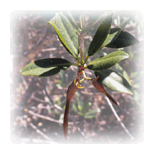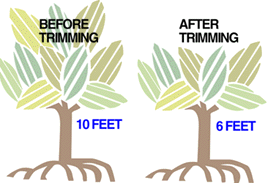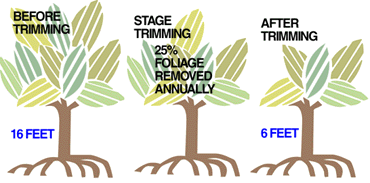South Florida is a region of changing landscapes. Freshwater wetlands and cypress swamps historically stretched from coast to coast. Mangroves were common on the western and southern coastline and on the offshore islands. With the dredging of the Intracoastal Waterway (ICW) and the opening of new inlets to the ocean, environments more suitable to mangroves were created. As a result, mangroves became common along both sides of the ICW and in some places formed wide fringes over a mile wide.
 Today the ecology of South Florida is very different and only the very southern counties continue to have vast mangrove preserves. These mangrove regions are important to South Florida’s economy and ecology and form an important ecological link with the freshwater cypress and Everglades wetlands. Mangroves support marine food chains and serve as habitat and nursery grounds for many species of birds, fish and wildlife. In Broward County, West Lake Park’s 1,500+ acres of coastal mangrove wetlands is one of the largest urban parks in Florida. It is rich in native vegetation and wildlife, including many threatened and endangered species.
Today the ecology of South Florida is very different and only the very southern counties continue to have vast mangrove preserves. These mangrove regions are important to South Florida’s economy and ecology and form an important ecological link with the freshwater cypress and Everglades wetlands. Mangroves support marine food chains and serve as habitat and nursery grounds for many species of birds, fish and wildlife. In Broward County, West Lake Park’s 1,500+ acres of coastal mangrove wetlands is one of the largest urban parks in Florida. It is rich in native vegetation and wildlife, including many threatened and endangered species.
Within the urban landscape of canals and seawalls, it is common to find small fringes of mangroves that continue to provide habitat and refuge for native fauna. These areas are important for shoreline stabilization, filter nutrients from upland sources and maintain water quality. For these reasons, mangrove areas of varying locations and sizes are protected and conserved. The Broward County Aquatic and Wetlands Resources Section regulates and enforces the protection of mangroves throughout the county in order to ensure that mangroves continue to remain an asset for the future.
 Red Mangrove (Rhizophora mangle)
Red Mangrove (Rhizophora mangle)
A medium sized tree typically found in tidal areas or offshore islands. Leaves are elliptical and leathery with a shiny deep green color above and pale underneath. The seeds germinate while still attached on the tree and the pencil-shaped propagules can be up to 10 inches long. The most noticeable feature of red mangroves is the interlocking network of prop-roots that arise from the trunk and branches to shallowly penetrate the soil. The tree bears yellow flowers all year round but predominantly so in spring and summer.
Black Mangrove (Avicennia germinans)
 A medium sized tree with oblong leaves often encrusted with salt. The leaves tend to be light grey to whitish on the underside. The black mangrove is most easily recognized by a system of upward growing pencil roots that radiate out from the tree. These finger like projections often form a carpet around the tree and are thought to help the plant breathe.
A medium sized tree with oblong leaves often encrusted with salt. The leaves tend to be light grey to whitish on the underside. The black mangrove is most easily recognized by a system of upward growing pencil roots that radiate out from the tree. These finger like projections often form a carpet around the tree and are thought to help the plant breathe.
White Mangrove (Laguncularia racemosa)
A medium sized tree with broad flattened oval leaves that branch out from the stem opposite each other. At the base of the leaf are a distinctive pair of salt glands. Flowering occurs in spring and early summer.
Definitions
- MANGROVE ALTERATION: Defoliation, destruction and or removal of mangroves
- MANGROVE: Any specimen of the red (Rhizophora mangle) , black (Avicennia germinans) , or white (Laguncularia racemosa) mangroves.
- MANGROVE MITIGATION: Areas on public or private lands that were created, enhanced, restored or preserved to compensate for the loss of mangroves elsewhere.
- RIPARIAN MANGROVE FRINGE: Mangroves growing along the shoreline; the fringe does not exceed fifty feet in width and does not include mangroves on uninhabited islands, or mangroves set aside as conservation, preservation or mitigation areas that were set up without trimming provisions.
- TRIMMING: Cut branches, twigs or limbs.
Mangrove Trimming
Due to their ecological importance, mangroves have long enjoyed protection through State of Florida regulations concerning removal and trimming. In an effort to simplify the process, the Legislature passed legislation in 1995, amended in 1996, titled the Mangrove Protection Rule, Section 403.9321 through 403.9333 Florida Statutes. The Florida Department of Environmental Protection coordinates the implementation of the Rule in conjunction with local governments, such as Broward County, that are designated to act as the state’s local representatives.
 Trimming Methods
Trimming Methods
Trimming is restricted to a height of 6 feet. This is the minimum height at which the mangrove should stand. Canopy trimming should be done in stages to prevent injury and defoliation of the tree.

